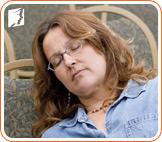Though the two terms are often used interchangeably, there are important differences between panic attacks and panic disorder, and understanding the distinction is crucial for those who may be suffering from the latter. Read on to learn more about both.
Causes
The root cause of panic disorder - particularly in women going through menopause - is hormonal fluctuation. Low levels of estrogen combined with rising levels of the stress hormone cortisol can raise blood sugar, causing sporadic and repeated panic attacks. Genetics and brain chemistry both play a role in your likelihood of experiencing panic attacks or developing panic disorder.

Panic attacks can strike at any time, and they can either be isolated incidents or a symptom of panic disorder. They often result from a traumatic event or stressful situation, but poor nutrition and hormonal fluctuation can be contributors as well. There are a number of things that commonly trigger panic attacks.
Triggers
Immediate triggers for panic attacks, which can turn into panic disorder, can be grouped into three categories: situational, psychological, and substances.
- Situational triggers. Situational triggers are often places or events that remind you of a traumatic time or stressful situation that brings on an attack.
- Psychological triggers. Psychological triggers are overly anxious thoughts or memories of trauma that result in a physical reaction.

- Substances. Substance-induced panic attacks are caused most frequently by either caffeine or alcohol. The former is a stimulant that makes you jittery and sharpens sensations, while the latter affects your nervous system directly. Incidentally, alcoholism is linked to panic disorder.
Removing these triggers from your life through lifestyle changes and therapy sessions can reduce and even eliminate panic attacks. If you're experiencing repeated episodes that point to panic disorder, the same methods can reduce frequency of attacks and help you manage the condition.
Symptoms
It's essential to understand the symptoms of a panic attack in order to stay calm when they occur. It's common to feel an increase in heart rate accompanied by shorter, quickened breath, excessive sweating, and rushes of adrenaline. Chest pain and dizziness may make you feel like you are having a heart attack, and you might experience abdominal distress. A tingling sensation in the face and arms is also common.

Panic disorder can bring about a number of complications. The condition's primary symptom is the chronic recurrence of panic attacks, which can generate anxiety and fear of the next incident. This vicious circle of worry sometimes manifests itself in agoraphobia - the fear of going outdoors - or in stress symptoms like chronic fatigue. People with panic disorder can also become hyper-vigilant from constantly expecting another panic attack.
By employing this knowledge, you can treat and manage panic attacks successfully. If you've been through a panic attack at least once, try to discover the underlying causes and talk to your doctor about treatment options.
Sources
- American Psychiatric Association. (2015). Help with Anxiety Disorders. Retrieved January 14, 2016, from http://www.psychiatry.org/patients-families/anxiety-disorders
- National Institutes of Health. (n.d.). Panic Disorder - National Library of Medicine - PubMed Health. Retrieved January 14, 2016, from http://www.ncbi.nlm.nih.gov/pubmedhealth/PMH0001922/

